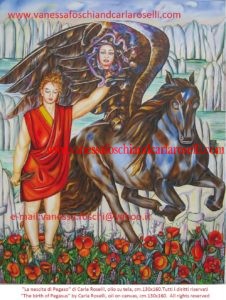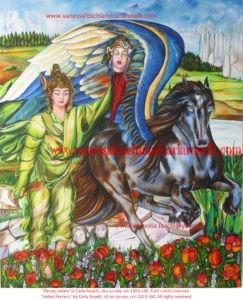
THE BIRTH OF PEGASUS
In this painting artist Carla Roselli captures the birth of Pegasus. It is the moment in which the winged horse Pegasus springs forward from the blood of his beheaded mother Medusa (Ovid, Metamorphoses IV, 786).
This myth has a double setting. According to some it took place in the land of the Hyperboreans, in northernmost Eurasia, beyond Scythia. According to others it occurred in the West, beyond the Ocean, near the garden of the Hesperides.
The artist realized both settings of the episode.
Poppies are depicted because they symbolize sleep . In her sleep the Gorgon Medusa was killed by Perseus (Ovid, Metamorphoses IV, 784).
The vetch is represented because it is a plant that blooms in the Underworld and it was there that the Gorgon was sent.
The broken statues are the petrified victims of Medusa.
Dr.Vanessa Foschi. May 2017. All rights reserved

LA NASCITA DI PEGASUS
Pegasus, il mitico cavallo alato, fu generato da Poseidone, il Dio Signore del mare, scuotitore della Terra e da Medusa all’ombra del Tempio di Atena.
Medusa era una delle tre Gorgoni, un tempo bellissima, poi tramutata da Atena in un mostro anguicrinito dal potere di fare impietrire gli esseri viventi con lo sguardo.
Pegasus sprizzò fuori dal sangue della Medusa quando Perseo la decapitò.
Questo mito ha una duplice ambientazione. Secondo alcuni ebbe luogo nel paese degli Iperborei, nelle regioni più settentrionali della terra, oltre la Scizia. Secondo altri avvenne ad Occidente, oltre l’oceano, vicino al giardino delle Esperidi.
L’artista ha realizzato entrambe le ambientazioni dell’episodio.
Nel quadro “La nascita di Pegasus” di Carla Roselli sono presenti i papaveri e la veccia, fiori sacri a Proserpina. La presenza del papavero, fiore dal noto potere soporifico vuole ricordare sia che la Medusa fu uccisa nel sonno, sia la sua appartenenza al regno degli Inferi.
Il colore del manto del cavallo ha la valenza del vocabolo greco “porphyreos” termine che designa i riflessi cangianti del mare in tempesta. Il croceo e lo scarlatto delle vesti dell’ Eroe sono segno di distinzione e di appartenenza a stirpe regale.
Dr. Vanessa Foschi. Gennaio 2001. Tutti i diritti riservati



